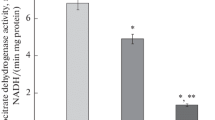Abstract
THE rat is known to synthesize ascorbic acid in the course of its normal metabolism. It has been observed by Longenecker and associates1 that this synthesis can be greatly stimulated, resulting in the high urinary excretion and tissue reserve of the vitamin, when the rats are given daily a variety of compounds, particularly narcotics like chloretone. It has been previously reported in several communications2–6from this laboratory that the high urinary excretion of ascorbic acid stimulated by chloretone can be completely suppressed, if the animals are made deficient in thiamine, riboflavin, pantothenic acid or folic acid. This action of the narcotic can be restored by correcting the respective deficiency with the particular vitamin. The effect of inanition has been taken into account by pair-feeding the experimental animals. The excretion under chloretone is unaffected by adrenalectomy or pancreatectomy of the rats. A definite inhibition of pyruvic acid oxidation by brain tissue of the rat has been observed in presence of chloretone under aerobic condition. The high urinary excretion of ascorbic acid stimulated in the rat under chloretone can also be almost entirely suppressed by the daily administration of either adenosine triphosphate, malic acid or thyroxine in suitable doses. The effect of chloretone is promptly restored when the administration of these compounds is stopped. Other compounds, such as adenosine diphosphate, adenylic acid, dinitrophenol, glutathione and dicarboxylic acids such as oxaloacetic, fumaric and succinic, have been tried without any such suppressive effect on the urinary excretion of ascorbic acid by the narcotized rat.
Similar content being viewed by others
References
Longenecker, H. E., Fricke, H. H., and King, C. G., J. Biol. Chem., 135, 497 (1940).
Roy, S. C., Roy, S. K., and Guha, B. C., Nature, 158, 238 (1946).
Roy, S. C., Roy, S. K., and Guha, B. C., Ann. Biochem. Exp. Med., 11, 73 (1951).
Technical Report, Scientific Advisory Board, Indian Council of Medical Research, New Delhi, for the year 1951, p. 40; ibid., 1952, p. 59
Ganguli, N. C., et al., Proc. Ind. Sci. Cong., Part III, 259 (1952); 362 (1953); 33 (1954).
Ganguli, N. C., thesis for doctorate, University of Calcutta, 1953.
Ghosh, B., J. Ind. Chem. Soc., 23, 99 (1946).
Benson, A. A., Bassham, J. A., Calvin, M., Goodale, T. C., Haas, V. A., and Stepka, W., J. Amer. Chem. Soc., 72, 1710 (1950).
Author information
Authors and Affiliations
Rights and permissions
About this article
Cite this article
GANGULI, N., ROY, S. & GUHA, B. Biosynthesis of I-Ascorbic Acid. Nature 174, 511–512 (1954). https://doi.org/10.1038/174511a0
Issue Date:
DOI: https://doi.org/10.1038/174511a0
- Springer Nature Limited





